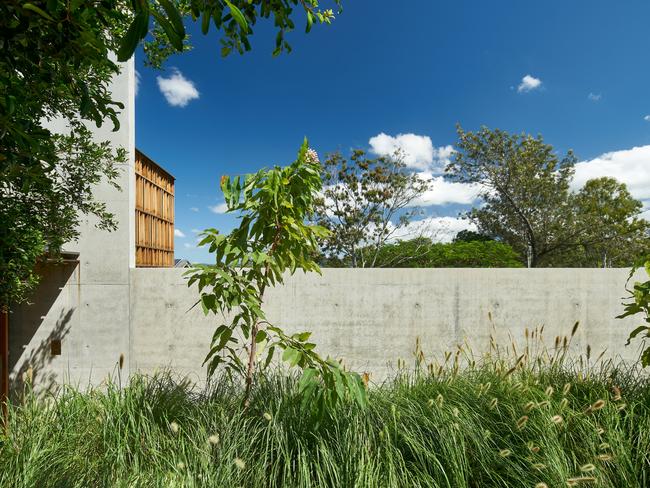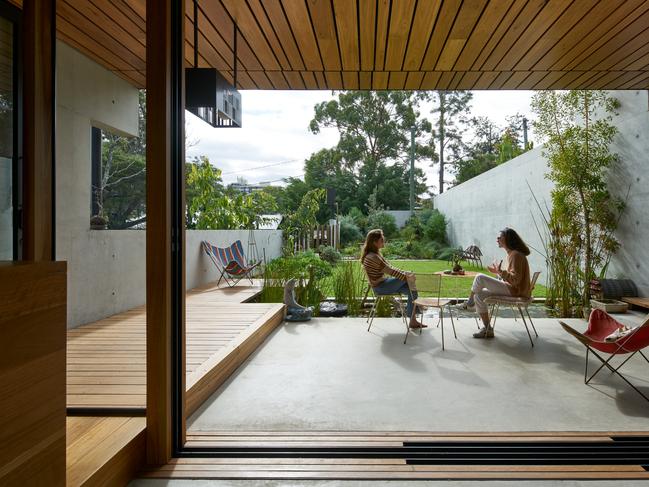Riverbank House, Brisbane: an award-winning design
They had a dramatic site: on a cliff beside the Brisbane River, with some remnant forest. And didn’t they make the most of it?

As sites go, this one was a standout: an 800sqm block on a cliff above the Brisbane River. “You could immediately see it was extraordinary,” says architect Hamilton Wilson. “To have remnant forest on the riverbank here is so rare. We all saw that as an asset because there’s nothing more beautiful than looking at water through trees.” His firm designed both the house and the landscape for the project, a finalist in the Gardens category of the 2021 Houses Awards and a winner in Queensland’s Australian Institute of Landscape Architects Awards.
At the Highgate Hill site, which offers unencumbered views to the north and across a reserve to the east, the house has been lifted up to “float” above the garden, allowing a direct connection between the landscapes at each end of the property; it also preserves the naturally sloping terrain.

“The house is almost a shelter over our heads,” says one of the owners, a professional couple with three adult children. “Often I look up and see a moth or butterfly flying through unimpeded, not even knowing it went into a house and came out the other side.”

A long, 4m-high masonry wall from the street to the house creates a private courtyard feel to the front garden, editing out unwanted views and helping to anchor the house. Visitors are led down a walkway on the other side of this spine wall, the path flanked by flowering gums and native foxtail grass (Pennisetum alopecuroides). The sense of mystery culminates at a pavilion door where they transition through an opening in the wall to suddenly experience the house in its setting. “There’s a moment when you get to understand the building in one hit,” says Wilson.
In the front garden, native plants include banksias, eucalypts, coastal rosemary (Westringia), grass trees (Xanthorrhoea) and various cultivars of Lomandra. One section is devoted to a small vegetable garden, while the large pond, home to fish and frogs, also contains native plants.

On the river side of the house, the land slopes steeply to the water. The old stone walkways were kept as much as possible and existing stone walls stabilised, while carefully preserving the mature trees. Elevated timber walkways are designed to avoid interfering with tree roots and ground cover, while a viewing platform floats above the water’s edge. The owners are keen rowers as well as gardeners, and insisted the plantings all be waterwise natives suited to the locality.
That fits Wilson’s ethos. He worked with both his architect father and his mother, Beth Wilson, a botanist and renowned landscape architect who was keen on working with native plants. Her 2018 book Brisbane Houses with Gardens, which she wrote while in palliative care, won an award the year she died. “She was a bit of a legend,” Wilson says fondly.
Riverbank House was a four-year project, completed in early 2020. “The environment outside is as important, if not more important, than the house,” says the owner. “We always feel as if we’re part of nature and I think that’s important for humans to have in their lives.”
Q&A
We filled in the swimming pool to gain a level area where our grandsons can play. What low
plants could help soften the edge of the old coping and prevent tripping? Helen Mahoney, Brisbane
For long flowering, look at Evolvulus ‘Blue My Mind’ and Cuphea Cupid series. Gardenia radicans is perfumed but needs water. Tricolour star jasmine gives foliage colour all year in sun or shade, is robust and easy care. Loropetalum ‘Purple Pixie’ has plum foliage and hot pink spring flowers. Strappy-leaved clumping plants like Lomandra ‘Lime Tuff’ or ‘Little Con’, or one of the dwarf agapanthus varieties, are low maintenance and tough in sun.
When should I start pruning my row of lillypillies, planted 18 months ago, to make a hedge? Barry Powells, Coffs Harbour, NSW
Hedges should be pruned from the start rather than letting them grow tall and thin. Frequent and light tip-pruning is the key to creating bushy, dense hedges, as every shoot pruned should stimulate two or three shoots from that point. This applies to any species of hedge. Prune any time there is active growth, except once flower buds start to form.
I’m trying to espalier lillypillies as a flattish screen against an open wire fence. How often can I prune them and how aggressive can I be? Is there a spring season in Queensland? Brian Cavanagh, Sunshine Coast
The previous answer applies to you, too, in most respects. However in espalier work, you might tie some of the lateral shoots horizontally and remove all shoots facing forward. Lillypillies will reshoot from severe cuts into old branches. In your climate, you can prune any time except in very hot, dry weather.

Send your questions to: helenyoungtwig@gmail.com or Helen Young, PO Box 3098, Willoughby North, NSW 2068. July’s best question wins a Darlac splitting axe ($99) and camping hatchet ($55) from mrfothergills.com.au



